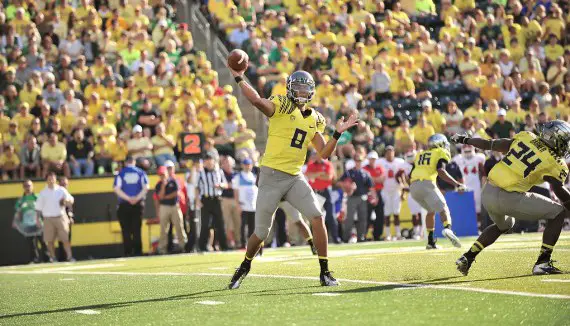How do the Ducks stop 1,200 pounds of defensive muscle with exceptional speed from crushing our quarterback? What are the tactics to stop blitzes? It is only fitting to give some recognition to the big boys up front, since this is not an easy assignment. The men who battle in the trenches every single offensive play are the reason big runs and passes happen in the high-scoring Oregon Offense. We’re going to look at how important pass protection and blitz pick-up is by breaking down all that transpires in a single play.
When you look at the offensive line, you obviously start with five players to protect the quarterback on passing downs, but you can also add to the protection provided by the running back and/or tight end. In most situations the running back and offensive line will be responsible for picking up blitzes with the exception of the running back releasing for a pass route. The offensive line, running backs and quarterback all have to be on the same page to make sure they understand their responsibilities.
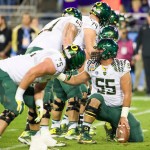
Hroniss Grasu
When the offense is set before the snap, we see the center call out the front, while the running back will typically give them a call in return so everyone knows their role. The offensive linemen have to be great communicators to make sure all defensive rushers are blocked.
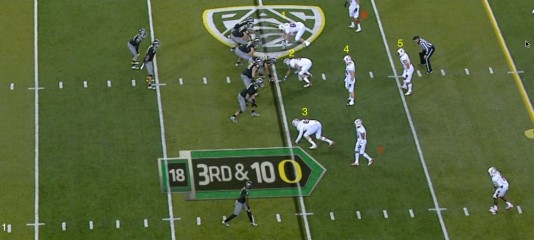
If you look at the picture above, you can see there are three down defensive lineman with four linebackers, commonly known as a 3-4 defense. In a “typical” situation the offensive line will be responsible for the three down lineman and the two linebackers within the tackle box (#1-5 above). The running back will give the offensive line a call for either right or left which lets the offensive line know the running back is picking up the outside linebacker to the called side.
In most game planning scenarios coaches will be able to identify which opposing players blitz the most. If they realize one or both of the inside linebackers do not blitz very often, but the outside linebackers do, they will adjust their calls to make sure the offensive line picks up the primary blitzers to help free up the running back and/or tight end. The running back and/or the Tight End are responsible for the outside linebackers numbered in orange in the picture above.
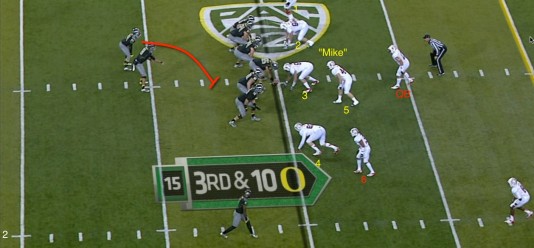
Progressing the film above shows how the defense begins to reveal itself prior to the snap of the ball. In some situations this causes major confusion with the blitz pick up, but most of the time the rules and assignments are already declared and it helps sort out where everyone will be coming from. In this particular situation it looks like the offense is not counting on number five to be a primary blitzer. Although he may not be a primary blitzer, the quarterback must be aware of the possibility of him blitzing and know his whereabouts.
This leaves six more defenders the offensive line and running back must account for. The center will make a call identifying the front and declaring who the “Mike” linebacker is. In pass protection the “Mike” is not always the true middle linebacker, but rather the linebacker the offensive line must account for. The running back has made a “Roger” or a “Right” call and he is going to be responsible for the defender labeled six while leaving the remainder of the rushers for the offensive line to block.
Why is the deep defender above labeled with an orange QB? He is the quarterback’s responsibility and if he blitzes the defense would have seven rushers against our six blockers. As soon as the quarterback sees him coming—he must find the receivers in the “hot routes” and get the ball out of his hands and to them immediately.
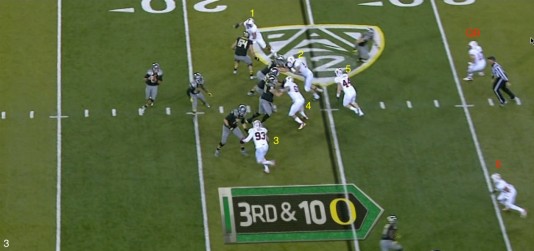
After the snap (above), you can see how the number five defender did not blitz immediately and the number six defender who “showed” blitz originally, ended up dropping into coverage instead. This allowed the offense to have six protectors on five defenders. The offensive line was able to pick up this fairly easily.
One advantage the offensive line has in stopping the defenders is how they take their pass blocking sets to gain depth and allow the defenders to sort themselves out more as they attack the quarterback. The picture above shows how the “Mike” backer originally indicated he was rushing from the left, but looped around to the right to attack another gap to confuse the blockers.
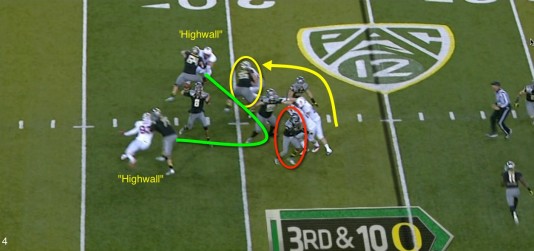
Finally the picture above shows you how a great plan comes together. If you look at the two players engaged (circled in yellow), you can see how the center peeled off and picked up the “Mike” who looped around from his original alignment. This is an excellent job of great communication taking place. The player circled in red is the running back whose original blocking assignment (#6) dropped into coverage, so he stayed in to help chip on any defender showing he was a threat.
The two offensive tackles do a great job of “high-walling” their defenders. This is a term used for forcing the pass rush to the outside and helping to create the “pocket” for the quarterback to have room to work. The three interior linemen do an excellent job as well not letting the interior defensive lineman get a push backward from the inside to disrupt the pocket and force the quarterback to scramble.
When you have great communication and unselfish players working together on the offensive line, you create the explosive offense we have all come to love. No wonder the Ducks are one of the best in the nation at preventing sacks!
I may be in Texas, but like you, “Oh how we love to learn about our Beloved Ducks!”
Todd Moore
(Featured Photo at top provided by Kevin Cline)
————————————————————————————————————————————————————–
ANNOUNCEMENTS
*Don’t miss our football analysis every Tuesday, our Recruiting Update every Wednesday, and our new Chip Kelly updates every Friday!
*If you would like to join the other 80+ volunteers at FishDuck.com, and have five hours a week to donate…we have slots open for Editors, Writers, Analysts, Photo Archivists, and Social Media Associates. Can you help us manage people? Consider our Sales Manager and Video Archive Manager positions. E-mail us at charles@fishduck.com
Related Articles:
Todd (Football Analyst) is a former high school defensive coordinator and current administrator in education. He is a football enthusiast of all levels and loves to talk ball to anyone who will listen. He has coached in a spread offense and while coordinating defense used a 4-3 and odd stack. He has coached the offensive line, wide receivers, linebackers and safeties. Todd currently reside in the great state of Texas with his wife and two beautiful daughters.

